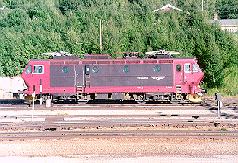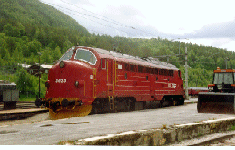One night in Dombås in September 2005.
When you really thought that the action was long gone and there was really nothing happening anymore.
Introduction to Dombås.

Dombås is located on the mainline through the Dovrefjell between Oslo - Trondheim and branches out the very scenic unelectrified line off to the coastal town of Åndalsnes. The line was a stronghold of Di.3. diesels, though during the nineties, for a short period of time Di.4s were used when the illfated Di.6 diesels were delivered. When the Di6 was returned to the manufactor, the Di.4.s returned back to Nordland-line. Today Di8 class centercabs supplements the venerable Di.3.s.
The cramped yard with its interesting trackwork is located on a hillside and ending to a tunnels on each end. To make the site even more as a modelrailroad the yard slopes down to the west. All this and the equipment available as models makes the location very modelable. All the pictures here are from a number of trips to Norway I have taken since 1993. Some of the equipment seen on more earlier photos are today withdrawn from service and scrapped.
But during the summers The Norwegian Railroad Club NJK offers excursiontrains with steam and old wooden cars to Åndalnes and stores the equipment between the runs in the yard. The town itself is a very small one consisting at the neighborhood of the station of a number of the houses. At the hillside a number of look a like row of smaller residenses. At north the area beoynd the station is dominated by a large mall with a large parkinglot, and a number of gastations. Here the highway E6 interscets with the highway to Åndalsnes. Towards Trondheim the E6 grades its way upp to the pass of Dovrefjell. The railroad goes further to north to hairpin its way to the very same pass.
History

The view of the old station which was destroyed in a fire during WWII. The wealth of rails and supplys dates this picture to the before the thirties as the lines to north and the Rauma-line was opened during the twenties.
Dombås was opened in 1913 as the northernmost part of Eidsvoll - Dombåsbanen at the foot of the Dovrefjell. In 1921 the line was extended to Stören where it connected the narrowgauge Rörosbanen which ran east of the Dovre Mountains by Röros to Hamar. The line Stören - Trondheim was standardgauged in 1921. In 1924, The Rauma-line to the coastal town called Åndalsnes was opened and the station became a junction for the two lines. During the world war II the orginal small station was destroyed and was replaced by the new station in 1941.

The new stationbuilding from 1941.
The Dovre line was elctrified between Eidsvoll - Hamar in 1953, Hamar - Dombås in 1968. Dombås - Hjerkinn iin 1968 and Hjerkinn - Trondheim in 1970. One of the highlights on the line was the oretrains from Hjerkinn with doubleheaded El13.s and El14.s, but these were discontinued few years ago. The line has seen a major change in passanger traffic as the new highspeed tilt trains of the class BM 73 start running on the Dovreline and the new 2-unit Talent trains replaced Di3.s on passanger runs on the Rauma line.
The line today

El16 2212 in Dombås, Roco produced a model of this engine. Note
that one of the pantographs has been changed to a single strut one! see full size images of this and other Scandinavian units at

The busy mainline sees all kinds of service, from Intercity trains to regionaltrains, that usually is using consists from passangercars of B7-generation, to morecommon mixed consists of cars of earlier B3 and B5 generations. Many of these cars are still wearing earlier paintscheemes. Power during the 1990.es were any engines of El.13, El.14, El.16, El.17 or El.18 classes. Today, since the introduction of the Signatur-trains of type 73 on most intercity trains, the last coventional passanagertrains are consisted of El.18.s and various cars of B7 generation.
Before the arrival of the powerful and futuristic looking E18.s, the most trains using B7-generation cars were pulled by E17.s Freight trains consistes of all types of freight cars. Some of these trains are dominated by containers that are hauled from Bodö to southern Norway and visa versa. Unit trains of scrap metal is fairly common. The freights are pulled using E14.s or by a single or doubleheader sets of E.16.s. El16.s are more rarely used as according some of the engineers then engines lack that estra traction to battle up the grade over Dovre.
In 2005, the freights seem to be dominated by containers. Everything is hauled in containers, including oil and other fluids formally hauled in tank cars. The only exception is the articulated auto racks and articulated multi purpose cars from the Swedish forwarder Nordwagon registrated for Green Gargo. The day time very lull, but during few hours in the night the station still comes alive as Dombås is still a crew changing point, if you can call crew of one as crew.

The Di3.a class unit 3.633 in Dombås in 1993.
The di3.a class are the only NOHABs that
are Co-Cos The Di3.bs and the other of the
swedish built covered wagons are A1A-A1As.
The line to Åndalsnes offers more relaxed type of operation. The most common power were the venerable Di3a.s using single units on passangerruns as the consists are nothing but a few cars, and double heading on the freight from and to port of Åndalsnes. This year the scene is somewhat different with Talent dmu.s handling the passanger runs and Di8.s handling the freights.